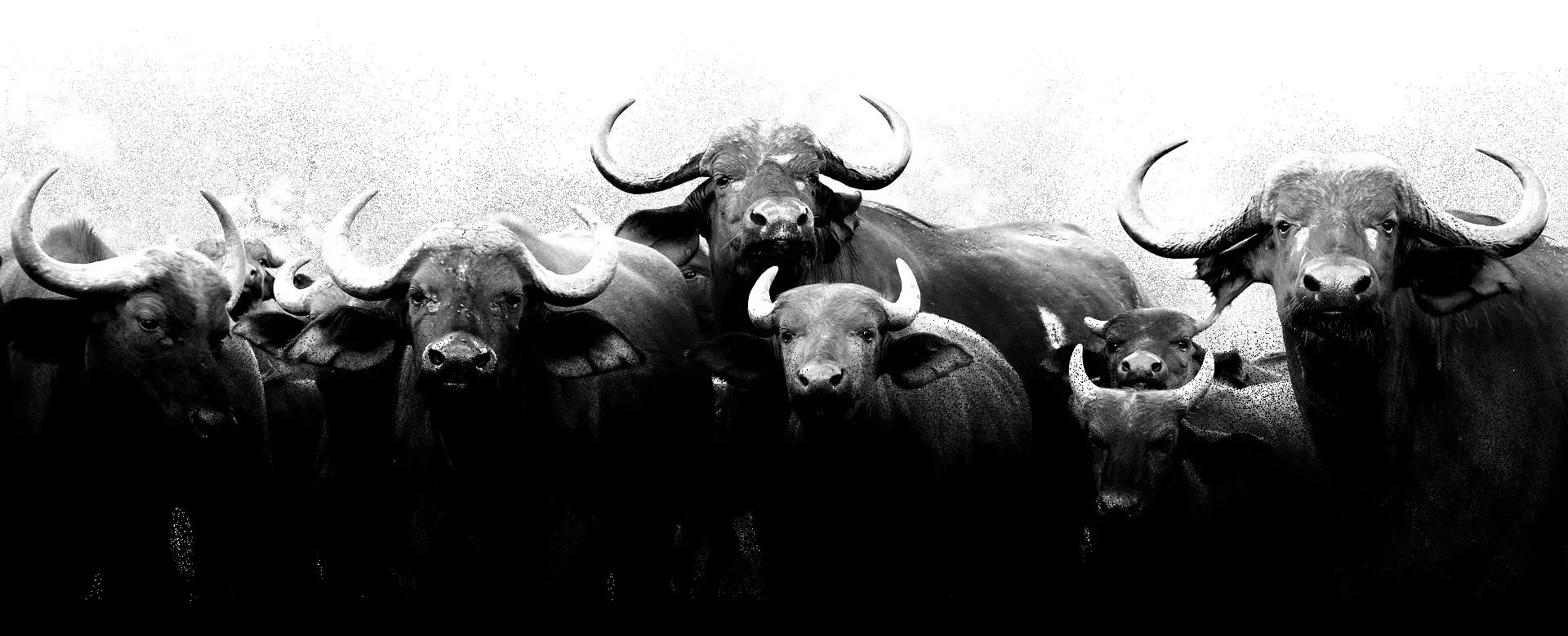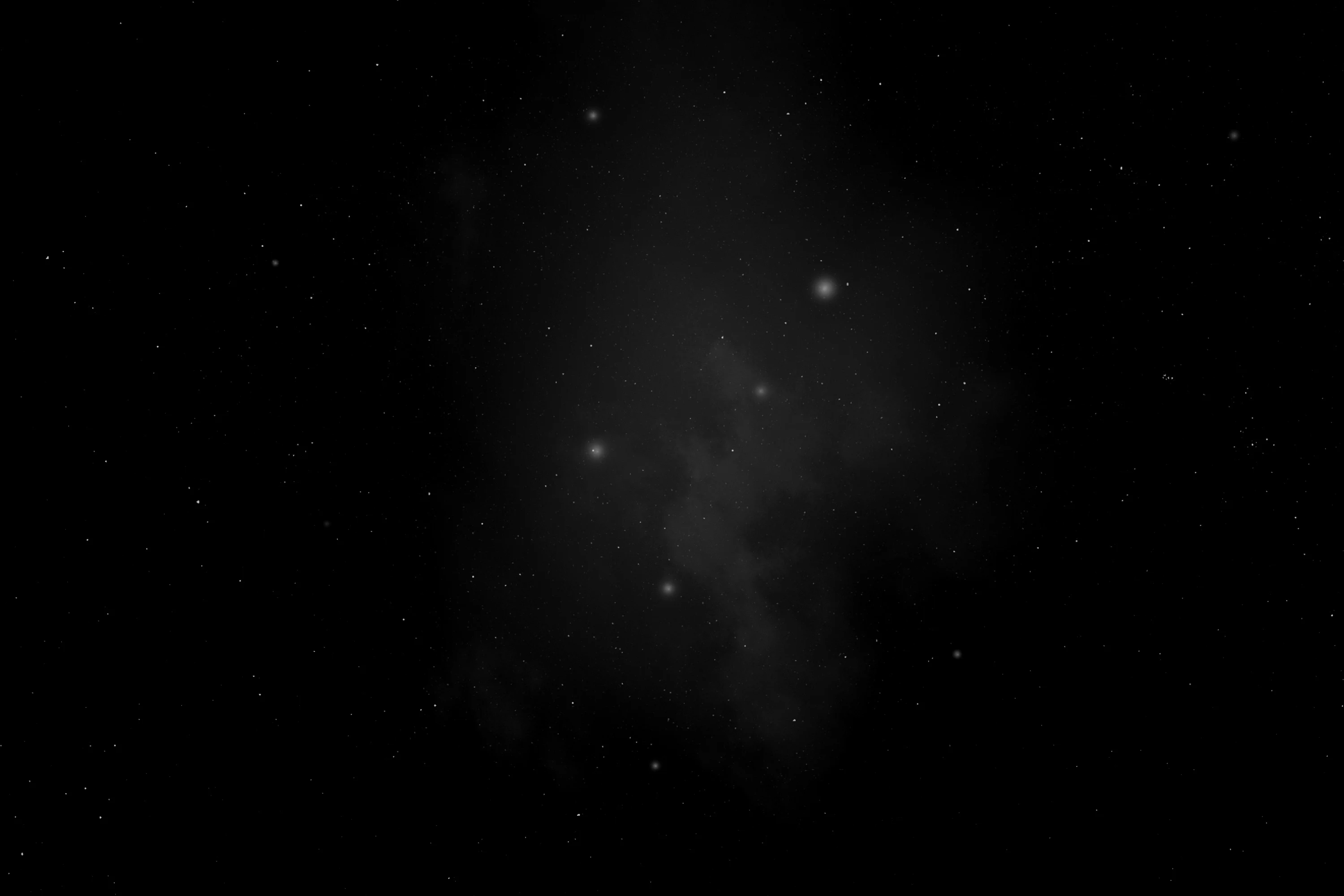
(Herpestidae)
Mongooses
Мангустові
A mongoose is a small terrestrial carnivorous mammal belonging to the family Herpestidae. This family has two subfamilies, the Herpestinae and the Mungotinae. The Herpestinae comprises 23 living species that are native to southern Europe, Africa and Asia, whereas the Mungotinae comprises 11 species native to Africa.
Characteristics
Mongooses are small carnivores. Their body lengths vary from around 230 mm to over 750 mm, and their weights range from less than 1 kg to around 5 or 6 kg. Most are brown or gray. A few species are striped, but most are not. A very few species have banded tails. The claws are not retractile. Herpestids tend to have small heads, pointed snouts, and short, rounded ears that are not as conspicuously erect or pointed as those of viverrids. Many have anal (not perianal, as in viverrids) glands that secrete a foul-smelling substance. Male herpestids have a baculum.
The skull of most herpestids is long and flattened. One pair of lower incisors appears to be slightly out of (raised above) the line defined by the incisor row. The carnassials are well developed. The last upper molar is not constricted in the middle. The dental formula is 3/3, 1/1, 3-4/3-4, 1-2/1-2 = 32-40. In the auditory bullae, the demarcation between ectotympanic and entotympanic parts of the bullae is clear, and in this family it is perpendicular to the long axis of the skull (it is oblique to that axis in members of the family Viverridae). The ectotympanic part of the bullae is approximately equal in size to the entotympanic part, or larger. A median lacerate foramen is present.
Behavior
Social life, characterized by well-structured social behavior and extensive use of scent marking, is common to nearly half of the mongoose genera. These social mongooses are diurnal, live in clans, and are primarily insectivorous. Sociality enables species such as dwarf mongooses (Helogale), banded mongooses (Mungos), and meerkats to forage during the day in open areas, despite considerable threats from aerial and terrestrial predators. By acting in concert, these species can avoid predation by some predators. Although mongooses consume a wide variety of foods – including invertebrates, small vertebrates, eggs, and even fruit– insects remain the mainstay of their diet. The most important insect prey are adult and larval beetles (Coleoptera), termites, grasshoppers (Caelifera), and other members of the order Orthoptera. One species, Meller’s mongoose (Rhynchogale melleri), appears to specialize in termites. In Africa, some termite species inhabit the dung of ungulates, as do the larvae of numerous dung beetles. Therefore, the abundance of African ungulates can influence mongoose populations. Many mongooses break the shells of crabs or bird eggs by hurling them backward between their hind legs against hard objects while standing upright. This behavior is otherwise known only in the genus Spilogale. Some species, such as the Indian mongoose, are well known for their ability to kill venomous snakes, including the king cobra. When hunting snakes, they rely on their agility, intelligence, and thick fur for protection.
Some herpestids are gregarious, occurring in colonies that sometimes include more than 50 individuals. Others are solitary. Most species are terrestrial, often making complex burrow systems, but a few include arboreal habitats in their foraging. Herpestids are found in a wide variety of habitats, ranging from desert to tropical forest. Some species are semiaquatic, readily entering the water to feed on fish, crabs and other aquatic organisms.
Mongooses have been introduced to a number of places, usually to help control snakes and rodent pests. Unfortunately, this has rarely, if ever worked, and the the introduced mongooses have generally been a worse problem than the creatures they were introduced to control.

(Herpestes ichneumon)
Egyptian Mongoose
Мангуста єгипетська
It is found primarily in sub-Saharan Africa, though it is absent from much of South Africa except along the eastern and south-eastern coasts. In North Africa, its range extends from northern and eastern Egypt southward to Ethiopia. It is also present from the Sinai Peninsula to southern Turkey, as well as on the Iberian Peninsula. It lives in swampy and marshy habitats near streams, rivers, lakes and in coastal areas.
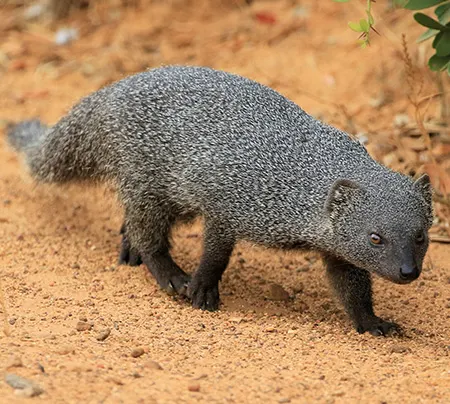
(Herpestes pulverulentus)
Cape Gray Mongoose
Капська сіра мангуста
It was thought to be endemic to the Cape Province, but it is now known to occur in much of the rest of South Africa and extend northward along the west to southern Angola. It inhabits macchia-type vegetation (fynbos), semi-desert scrub (Karoo), thicket and forest.

(Herpestes flavescens)
Angolan Slender Mongoose
Ангольська струнка мангуста
It is endemic to southern Africa, its range including south-western Angola and north-western Namibia. The natural habitat of this mongoose is kopjes, rocky outcrops and areas with large granite boulders, and the woodlands and slopes surrounding these features.

(Herpestes sanguineus)
Common Slender Mongoose
Струнка мангуста
It occurs throughout sub-Saharan Africa, where it is most common in the savannah and semiarid plains, but rarely recorded in densely forested areas and deserts.
The genus (Herpestes) also includes: Somali Slender Mongoose (Herpestes ochraceus).

(Atilax paludinosus)
Marsh Mongoose
Мангуста болотяна
It occurs across much of sub-Saharan Africa from Senegal and The Gambia to Ethiopia, and throughout much of Central, Eastern and parts of Southern Africa. It inhabits freshwater wetlands, marshes and swamps along slow-moving rivers and streams, in forested, jungle and savanna regions.
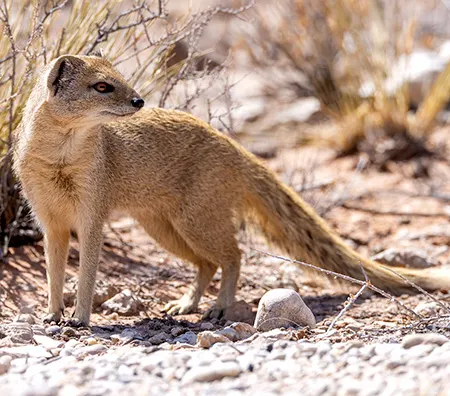
(Cynictis penicillata)
Yellow Mongoose
Мангуста жовта
It lives in open country, semi-desert scrubland and grasslands in Angola, Botswana, South Africa, Namibia, and Zimbabwe.
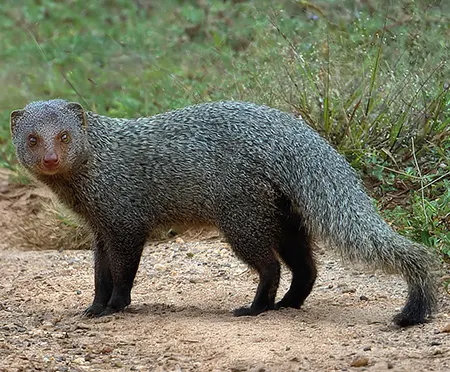
(Urva edwardsii)
Indian Grey Mongoose
Мангуста індійська сіра
It is found in Saudi Arabia, Kuwait, Bahrain, Iran, Afghanistan, Pakistan, India, Nepal, Sri Lanka, and Bangladesh. It inhabits open forests, scrublands and cultivated fields, often close to human habitation.

(Urva javanica)
Javan Mongoose
Мангуста яванська
It is native to Myanmar, Thailand, Cambodia, Vietnam, Laos, Peninsular Malaysia and the Indonesian islands of Sumatra and Java, where it lives up to an elevation of 1,800 m.
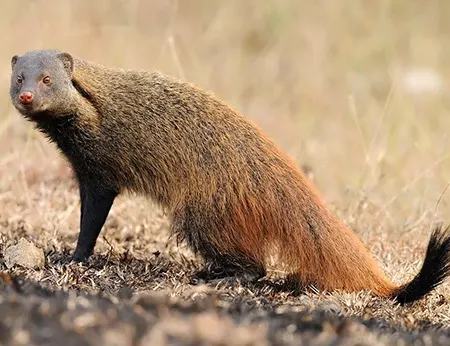
(Urva vitticolla)
Stripe-necked Mongoose
Мангуста смугастошия
It is native to forests and shrublands in southern India, particularly in the Western Ghats, and in Sri Lanka. It occurs at elevations up to 2,130 m.
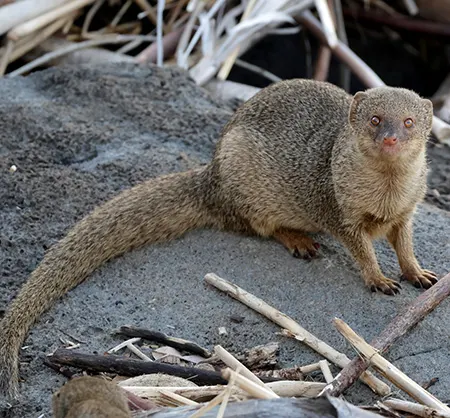
(Urva auropunctata)
Small Indian Mongoose
Мангуста індійська мала
It is distributed in Iraq through southeastern Iran, Afghanistan, Pakistan, India, Nepal, Bhutan, Bangladesh and Myanmar. It occurs at elevations of up to 2,100 m.
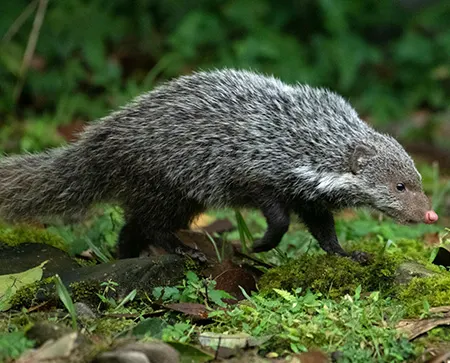
(Urva urva)
Crab-eating Mongoose
Мангуста-крабоїд
It is found from the north-eastern Indian subcontinent and Southeast Asia to southern China and Taiwan. It has been recorded at altitudes from sea level to 1,800 m. Found mainly near water, in evergreen and deciduous forests, shrubby areas, on plantations, and near human settlements.
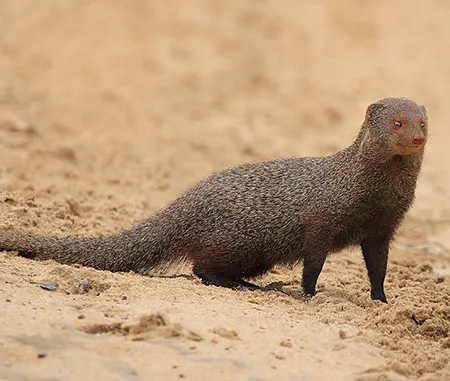
(Urva smithii)
Ruddy Mongoose
Мангуста руда
It is found on the Indian Peninsula and in Sri Lanka. It is mainly a forest-living animal and prefers more secluded areas.
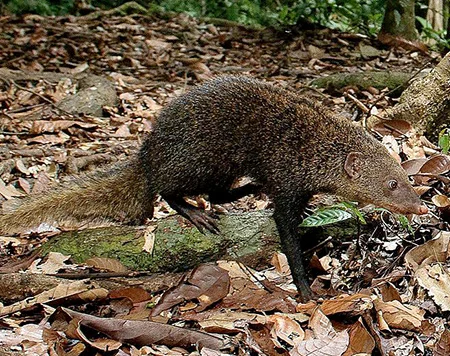
(Urva brachyura)
Short-tailed Mongoose
Мангуста короткохвоста
It is native to Peninsular Malaysia, Sumatra and Borneo. It inhabits evergreen forest and rural gardens from sea level to an elevation of 1,500 m.
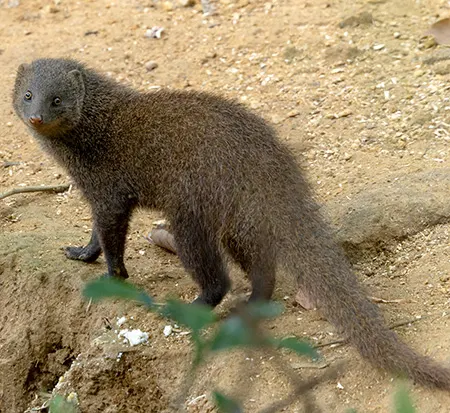
(Urva fusca)
Indian Brown Mongoose
Мангуста індійська бура
It is native to the Western Ghats in India and the western coast in Sri Lanka. It occurs at elevations of 700–1,300 m.
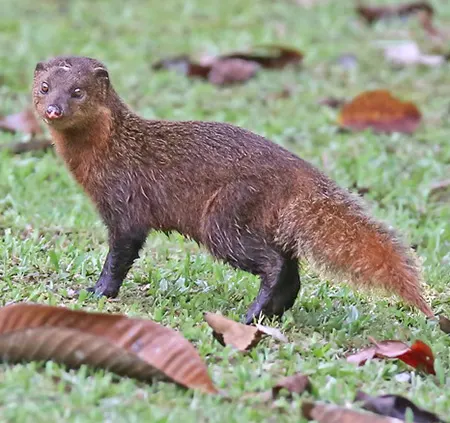
(Urva semitorquata)
Collared Mongoose
Мангуста ошийникова
It is native to Borneo and Sumatra. It is found in primary forests, disturbed habitats, lowlands, and hills.
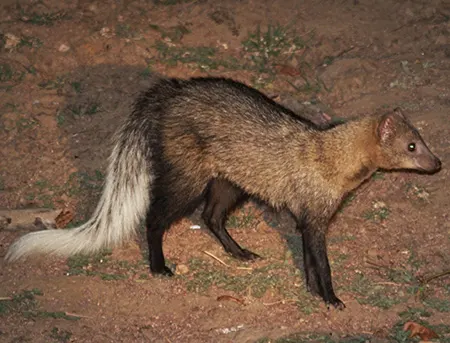
(Ichneumia albicauda)
White-tailed Mongoose
Мангуста білохвоста
It lives in most of Africa south of the Sahara, and the southern portion of the Arabian Peninsula. It lives in a wide range of habitats, from semi-desert to savanna woodland, but avoid moist areas like the Congo River basin or extremely arid areas.
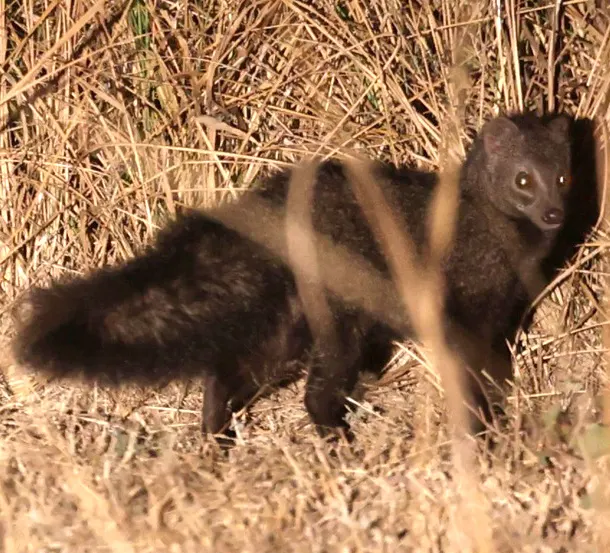
(Bdeogale crassicauda)
Bushy-tailed Mongoose
Мангуста пухнастохвоста
It is found in central Africa, from southern Kenya to central Mozambique. It inhabits foremost open shrubland and multilayered forest.
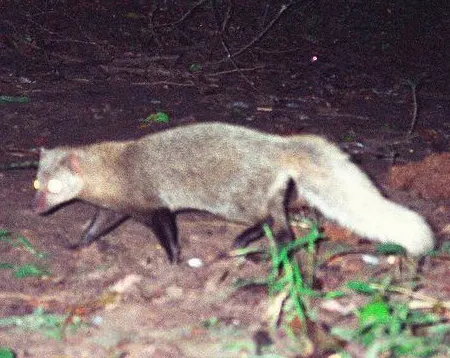
(Bdeogale jacksoni)
Jackson's Mongoose
Мангуста Джексона
It is native to montane forests in Kenya, Uganda, and Tanzania, where it occurs at elevations of up to 3,300 m.
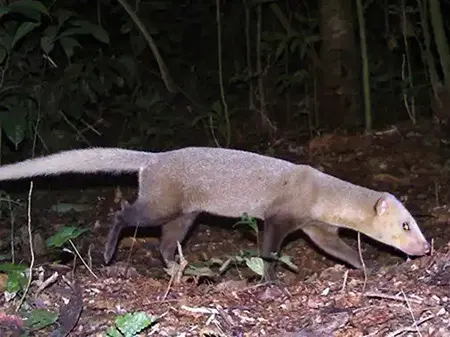
(Bdeogale nigripes)
Black-footed Mongoose
Мангуста чорнонога
It is native to Central Africa, where it inhabits deep deciduous forests from eastern Nigeria to the southern Democratic Republic of the Congo.
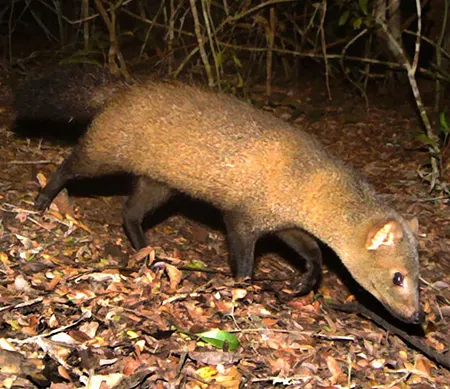
(Bdeogale omnivora)
Sokoke Dog Mongoose
Пухнастохвоста мангуста Сококе
It is endemic to the East African coastal forests of Tanzania and Kenya.
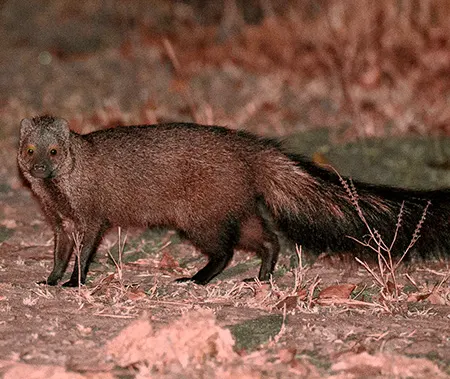
(Rhynchogale melleri)
Meller's Mongoose
Мангуста Меллера
It ranges from central Tanzania southward through Malawi, Zambia, Zimbabwe, and Mozambique, to Eswatini and north-eastern South Africa. It lives in savannas and is associated mainly with open woodland and grassland and marshy areas with termitaria.

(Paracynictis selousi)
Selous's Mongoose
Мангуста Селуса
It is endemic to Southern Africa. Its range includes Angola, Zambia, Malawi, Namibia, Botswana, Zimbabwe, Mozambique, and South Africa. It lives primarily in open scrub and woodland.

(Xenogale naso)
Long-nosed Mongoose
Мангуста довгоноса
It is native to wetlands and rainforests from the Niger Delta in Nigeria, Cameroon to the Central African Republic, Equatorial Guinea, Gabon, the Republic of the Congo and the Democratic Republic of the Congo.

(Mungos mungo)
Banded Mongoose
Мунго смугастий
It is found in a large part of East, Southeast and South-Central Africa. There are also populations in the northern savannas of West Africa. It lives in savannas, open forests and grassland, especially near water, but also in dry, thorny bushland, though not in deserts.
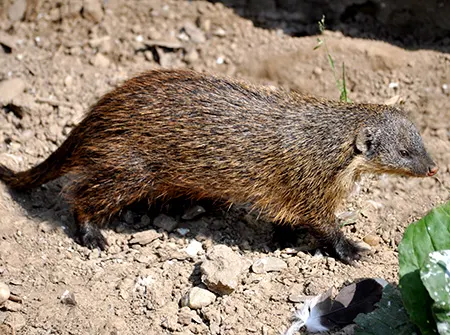
(Mungos gambianus)
Gambian Mongoose
Мунго гамбійський
It is endemic to West Africa, where it inhabits mesic savannas and woodlands, ranging from Senegal and Gambia in the west to Nigeria in the east.
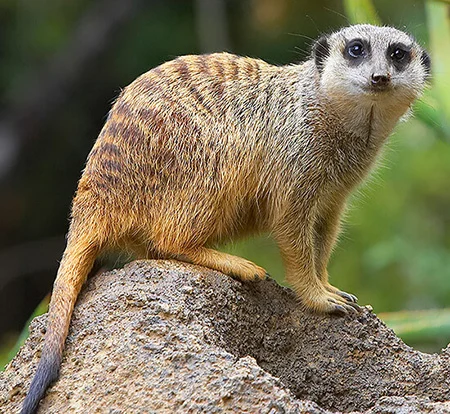
(Suricata suricatta)
Meerkat
Сурикат
It occurs in south-western Botswana, western and southern Namibia, northern and western South Africa; the range barely extends into southwestern Angola. It lives in areas with stony, often calcareous ground in a variety of arid, open habitats with little woody vegetation.

(Crossarchus alexandri)
Alexander's Kusimanse
Кузіманза Александера
It is endemic to central Africa, where it inhabits lowland and montane rainforests in the Democratic Republic of the Congo, bounded to the north by the Ubangi River and to the south by the Kasai River. It is also present in western Uganda. It occurs at elevations 1,500–2,900 m.
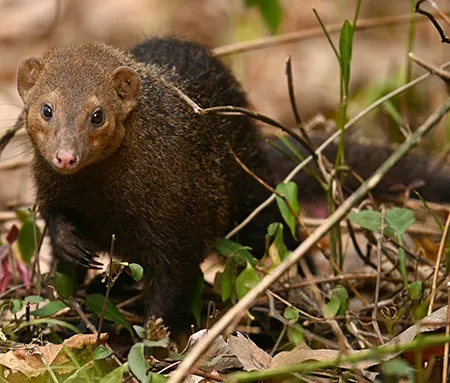
(Crossarchus platycephalus)
Flat-headed Kusimanse
Кузіманза плоскоголова
It is native to central Africa, extends from southern Benin and southern Nigeria through Cameroon to the Central African Republic and the north-western Republic of the Congo. Habitat is mainly the undergrowth of tropical rainforests and riparian forests.
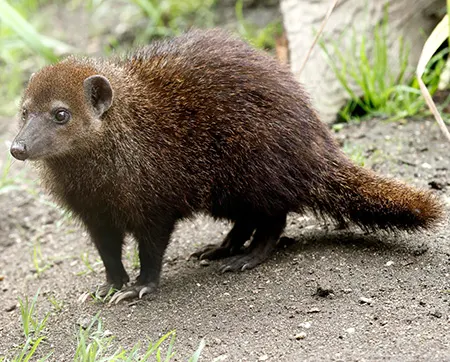
(Crossarchus obscurus)
Common Kusimanse
Кузіманза звичайна
It is found in the west African countries of Ghana, Côte d’Ivoire, Benin, Liberia, and Sierra Leone. It lives in forested areas near water, at elevations around 1,000 m.
The genus (Crossarchus) also includes: Angolan Kusimanse (Crossarchus ansorgei).
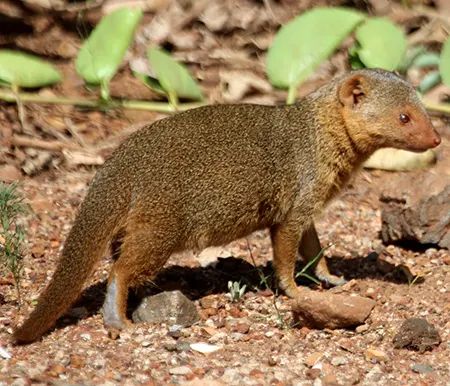
(Helogale parvula)
Common Dwarf Mongoose
Звичайна карликова мангуста
It ranges from East to southern Central Africa, from Eritrea and Ethiopia to the provinces of Limpopo and Mpumalanga in South Africa. It inhabits primarily dry grassland, open forests and bushland up to an elevation of 2,000 m.
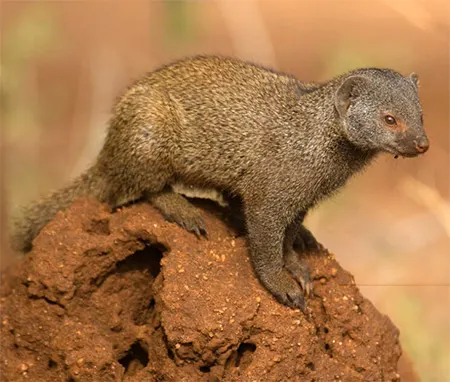
(Helogale hirtula)
Ethiopian Dwarf Mongoose
Ефіопська карликова мангуста
It is native to East Africa, particularly Ethiopia, Kenya, and Somalia. It occurs at elevations of up to 600 m.
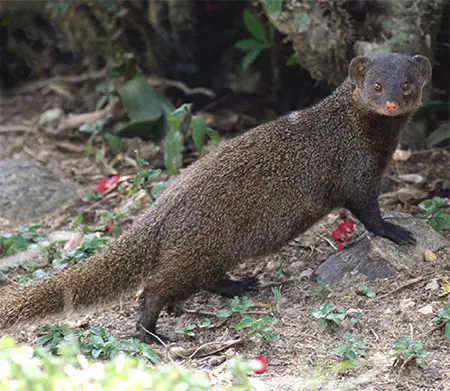
(Dologale dybowskii)
Pousargues's Mongoose
Мангуст Поусаргуса
It ranges from northern Democratic Republic of the Congo, South Sudan, Central African Republic to western Uganda.
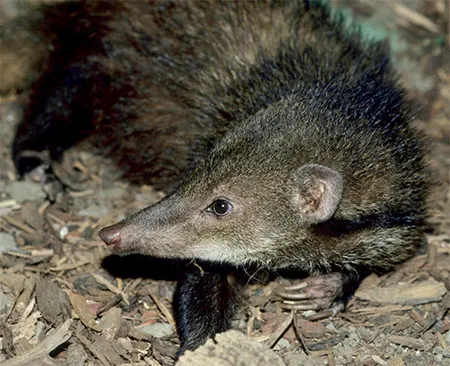
(Liberiictis kuhni)
Liberian Mongoose
Мангуста ліберійська
Known only from north-eastern Liberia and western Côte d’Ivoire. It inhabits primary and secondary forests, and is found mainly in swampy forests and riverbeds with sandy soils.
